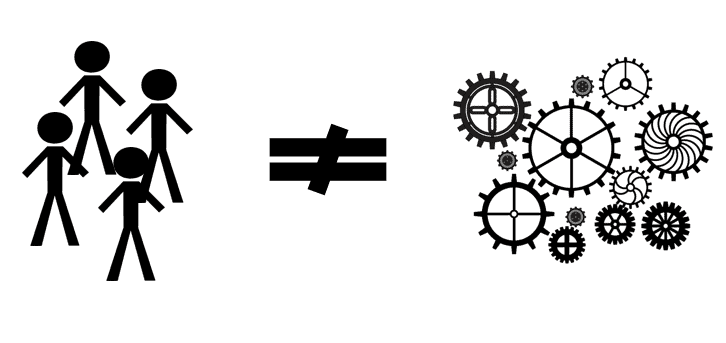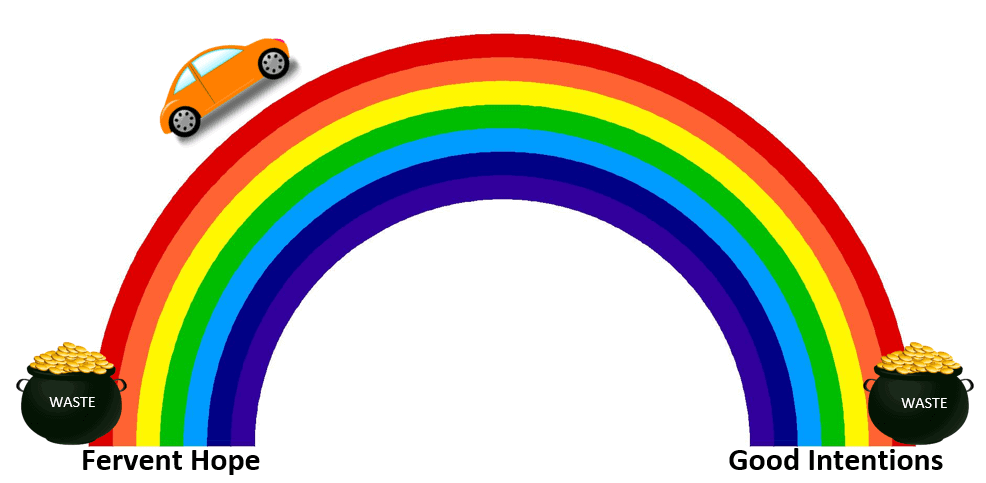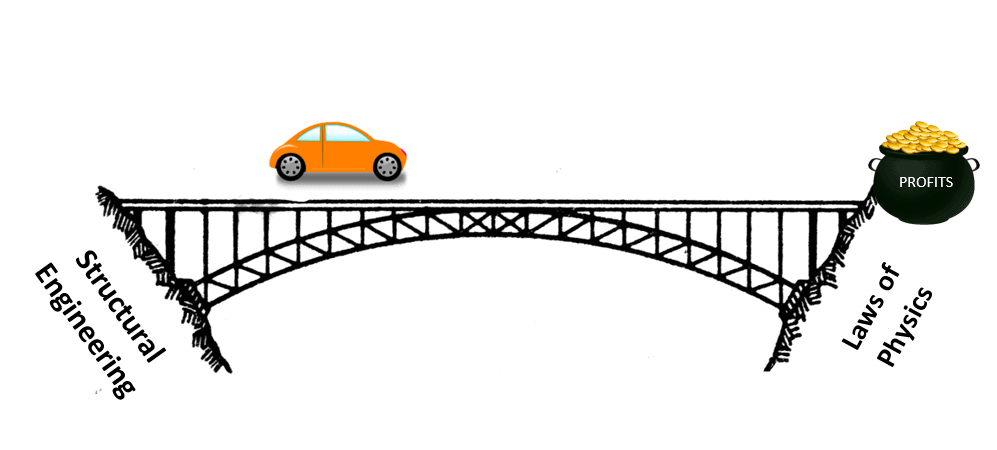Business leaders I know react one of two ways to this statement.
- Ha! It goes to show what you know. We don’t bother with that fluff. We’re too busy working. Our leaders learn on the job.
- No way! We know how important it is to equip our new leaders with how to do things. We know we need to groom future leaders. We do stuff…and things…and read books by Lencioni, Collins, Reis, and Pink.
To group 1, I don’t need to say anything because you aren’t reading this.
To group 2, yes. I’m talking to you. I am you. So this stuff is tricky. And at least we’re doing something, right?
I’ll say it again.
You are almost certainly wasting money on leadership development.
But it’s hard to know how much or what part.
In theory, we know having good leadership is important for business success. We know that doing things that evolve poor leadership into good leadership and good leadership into better leadership is good for the business. Where it gets murky, is knowing how to dial in our leadership development investment so we’re getting best bang for our buck. To add to the confusion, everywhere you look, there’s another leadership expert telling you how things should be (the thing they sell, of course.)
And here I am, adding to the noise.
Now that I’ve got your attention, how would you like to inject management science and organizational engineering know-how into your leadership development investments so you can be less haphazard and more purposeful?
Inject science and engineering is what I aim to do here.
This post is a continuation of my last post on the biggest reasons businesses fail to scale and thrive. In sum, the most important reason businesses fail to scale is right leadership and that current methods for determining right leadership lack precision and objectivity. There is a better way.
In a previous post, I also talked about the criteria for getting the right people in leadership roles. There’s more I can say about fine-tuning your ability to select the right people for manager roles, and I probably will someday.
Today, in this post, we will talk about leadership development and its role in helping right leadership be even right-er.
Right-er? Yes, by right-er I mean more adept at the execution part of the formula. By right-er, I mean more adept at orienting and coordinating the creativity of human beings. By right-er, I mean maximizing the capabilities of your people. These things matter for your business.
Why is that?
Leadership is right-people-right-seats to the power of two.
First, we need to do a great job of getting right people in the management seats. Leaders, once in those seats, are the people who are responsible for getting other seats filled by right people. If you don’t do the first thing well, you are almost certain to fail on the second thing. Restating this point, if you don’t get right people in leadership seats, you will mess up a whole lot of other seats too. Even more, if you don’t do the right-people-right-seats part well, you can forget about effective execution.
This is about strategy execution.
Great leadership is about great strategy execution.
The only way any business succeeds—your business succeeds– is by converting the ingenuity, energy, and creativity of humans into business value. The more this people-energy is amplified, harmonized, and pointed in the same direction—that’s great leadership. The more this people-energy is lost, re-directed, or working at cross-purposes—that’s a lack in leadership.
I bet I know which one you prefer.
If you want your business to create value—and you do—then you want leaders who can do that. Which brings us to leadership development.
Leadership development is a system of practices that enable leaders in a business to lead well.
These practices are concerned with:
Leading well today. First, leadership development should enhance the capability of today’s leaders to lead well. By today’s leaders, I mean anybody who is currently responsible for the output of other people.
Leading well tomorrow. Leadership development should also mold leadership skills in future leaders so that you ensure tomorrow’s leaders can lead well. This includes some thought into how future leaders are identified, because not everyone is cut out for leadership.
Leaders are responsible for the outputs of other people.
This becomes an issue very early in a company’s growth. If you rely solely on the instincts of your team, you are very, very likely to have a mess. This may not be noticeable right away, but eventually you’ll have business dysfunction that stems from unintentionally poor leadership.
This is where leadership development investments come in. It’s not about feel-goods. It’s not just a cost you take on to boost retention. It’s about systematically amplifying your business value growth through people.
You get this. Now for the part we often flub up.
People are humans. Even the ones that work in your business.
This is important. It’s self-evident. Logical. Yet every day I see evidence of some business somewhere applying a policy or practice that requires people to not be human.
Let me offer some examples.
- Common error 1) People are rational actors that are motivated by financial upside—above all else.
- Common error 2) One motivation system will work equally well for all humans.
We often hold assumptions that lead us to create systems that don’t perform as well as we expect. Instead, we get unintended consequences.
[pullquote align=”normal” cite=”Laszlo Bock, Work Rules!”]You spend more time working than doing anything else in life. It’s not right that the experience of work, even at some of the best employers, should be so demotivating and dehumanizing.[/pullquote]
What is the truth about human nature? Social science has advanced leaps and bounds in our understanding about how humans decide, work, and behave.
Here’s what we know about humans. Because science.
- Humans are largely driven by subconscious drives.
- Humans are unique individuals, each with our own motives and priorities.
- Humans are social animals and are wired to group-orient, figuring out moment to moment who our in-group and out-group appears to be.
- Humans are seekers of dominance or submission according to their natural default and according to the context they are in at the moment.
- Humans are pattern recognizers, and when that fails, imposers of patterns that might actually be coincidental artifact.
- Humans are wired to work and create at their natural level of capability and build on that capability over time.
These are all human traits that are true and real, whether we want them to be or not. These traits show us to be irrational actors chasing social affiliation, dominance, pattern seeking, and a drive to create. While we all are subject to these subconscious influences, we each do it a little differently based on our own motives, needs, and ability.
This may sound abstract and fluffy-duffy. Hang with me.
My really, really important point…
If your managerial practices presume the actors have qualities that are inconsistent with human nature, you have poor design.

Poor design begets poor results. You do not want poor results. Well-meaning ignorance can’t make up for poor design. You still get poor results. And results matter.
If you aren’t an engineer, go ask one what happens when you design something that only works when physics bend to your hopes. Disaster, right?
To illustrate my point, let’s look at bridge-making as an analogy.
[thrive_text_block color=”green” headline=”A Tale of Two Bridges”] [/thrive_text_block]
Imagine two bridges.
One is built on fervent hope and good intentions.

The other is built on an understanding of the fundamentals of physics and structural engineering.

Which one do you want to drive on?
We know that rainbows and sunshine, while happy-making and bright, don’t provide us a sound foundation for getting from here to there.
We get that.
What’s less obvious is the analogous scenario in all of our businesses– that poorly constructed managerial and organizational practices endanger our business performance. It’s especially tricky to recognize because poor design is so prevalent, we think that’s just how it’s got to be.
It’s sad.
But it can be better. Much better.
Just like in engineering, there are principles that underlie how people work together at peak capacity. If your leaders apply these principles, you get better results. A certified professional engineer must learn and apply the principles of physics and structural engineering. Likewise, leadership development should enable your leaders to learn and apply the principles of human nature and organizational engineering.
This is how we avoid wasting money on leadership development.
Let’s talk about the principles of organizational engineering that are based on human nature.
- Work is a human act of creativity and judgment. If human judgment isn’t required to do something, it’s called software. Not work.
- People are wired to work at their full capacity and consistent with their personal motives and drives.
- The better the match between person and role the more effective (A) the conversion of people energy into business value, and (B) the more self-fulfilling the work is to the person.
- Right-sized hierarchies maximize trust and creativity and shared purpose. Hierarchies emerge because humans are wired to group orient and make sense of their role within the group.
- People want supervisors that can add value and context to their judgment when they hit a barrier.
- A manager is accountable for the performance of their direct reports.
- Accountability must be clear and equal to authority for every role or you get dysfunction.
NOTE: It’s beyond the scope of this post to describe each of these in detail. I might write about them later. I’m always happy to talk about how these apply to your work world.
Are your leaders learning and applying the principles of organizational engineering?
Right leadership is right-er when all leaders practice leading in ways that are consistent with all of the above principles. Is that true for you? For the other leaders in your business? Odds are that the leaders in your business have opportunities to improve.
What this has to do with wasting money on leadership development.
Think about what your leadership development investments focus on. Are you teaching principles or solving symptoms?
It’s easy to get off track.
What I’ve learned is that the symptoms of unsound organizational design and leadership practices look a lot like personality conflicts, poor communication, and a need to get rid of bad actors. So you go train managers how to get rid of people, give feedback, and communicate better.
Because unsound organizations are so common, a lot of leadership development teaches leaders how to address symptoms.
There’s room for that. You need that, because it feels necessary to address the problem you see. Yet, if you mistake these palliatives for solutions, you’ll keep solving the same problems over and over again.
Here’s the good news. If you have sound organizational design and your leaders apply these principles, you’ll have a lot fewer of those symptoms less often.
Effective leadership development cultivates sound management practices and an understanding of human nature.
Start with a good foundation.
The root of sound management practices is an understanding of how to handle the dilemmas you encounter as a leader. What do you do when your gut and your head push you to different conclusions? Better, what do you do when your gut isn’t even sure which way to go?
Making good decisions in the face of competing influences is hard work that matters. That’s the essence of leadership.
How do you apply this to your business?
Look back at the organizational engineering principles. What assumptions does your business have about people, management, and work that run afoul of these principles? If you, the leader, aren’t sure, I bet there are people in your business that could tell you. Whether it is safe for them to tell you, well, that depends.
Find a safe way for your people to tell you how to build a better organization.
Here are some questions to ask your team through your leaders, managers-once-removed, surveys, HR team, and/or other method.
- Does your work require your judgment and creativity? If not, what would change that?
- Does your role require you to work at your full mental capacity? Are the responsibilities of your role consistent with your talents, strengths, and preferences? If not, what would improve that?
- Is it clear to you what you are accountable for? Do you have authority to impact all of the things you are accountable for?
- Does your supervisor add value and context to your judgment when you hit a barrier?
- Does your manager demonstrate personal accountability for the success of your work output?
While this process would unearth useful feedback for individual managers, it’s the systematic trends that help you re-engineer your organization and practices for better results.
Get at the root cause and set a sound foundation for your leaders.
If you get stuck, contact me. I’m always happy to help.

